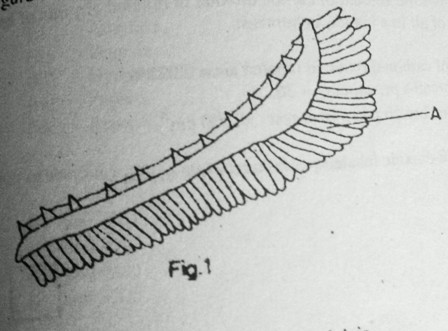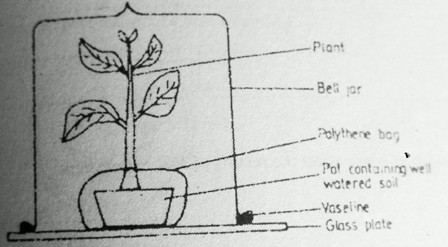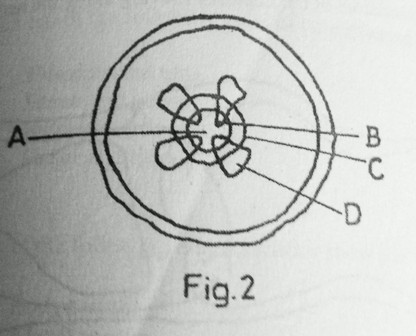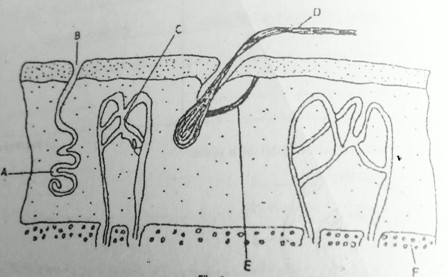PAPER 1
THEORY
SECTION A
Answer all questions in this section. For each question select the most correct option and write the letter representing it in the box provided.
1. The following are characteristics of blood vessels:
(i) Presence of valves.
(ii) Thick walls.
(iii) Wide lumen.
(iv) Elastic walls.
Which of the characteristics belong to veins?
A. (i) and (ii)
B. (i) and (iii)
C. (ii) and (iii)
D. (iii) and (iv)
2. Mucor undergoes a sexual reproduction to produce
A. Spores.
B. Zoospores.
C. Zygospores.
D. Sporangia
3. The fins which keep a fish stable in water are the
A. Anal and dorsal fins.
B. Dorsal and pelvic fins.
C. Caudal and pelvic fins.
D. Pelvic and pectoral fins.
4. Which one of the following is correct about diving cells at the tip of plant shoots?
They
A. Have large vacuoles.
B. Are specialized.
C. Have soft cell walls.
D. Have rigid cell walls.
5. Which one of the following contains the highest concentration of proteins?
A. Blood plasma.
B. Glomerular filtrate.
C. Urine.
D. Serum
6. Which one of the following would be observed in a plant growing in a soil lacking magnesium?
A. Poorly developed shoot system.
B. Yellowing of leaves.
C. Poorly developed root system.
D. Yellowing of buds.
7. What mode of nutritions is used by Rhizopus?
A. Heterotropism.
B. Autotropism.
C. Parasitism
D. Saprophytism.
8. Which one of the following would be the first to colonize a rocky surface?
A. Lichens.
B. Mosses.
C. Shrubs.
D. Ferns.
9. The blood constituents that help in the formation of blood clot at the site of an injury are
A. Platelets and erythrocytes.
B. Hormones and plasma.
C. Platelets and leucocytes.
D. Platelets and fibrinogen.
10. Figure 1 shows a gill of a fish.

The name and function of part labelled A is
A. Gill filaments for gaseous exchange.
B. Gill rakers for filtering food.
C. Gill bar for support.
D. Gill arch for increasing surface area.
11. Which one of the following would not be found in the glomerular filtrate?
A. Fibrinogen.
B. Glucose.
C. Mineral salts.
D. Urea.
12. Which one of the following is an example of discontinuous variation?
A. Height.
B. Weight.
C. Eye color in Drosophila.
D. Skin color.
13. Which one of the following sets consists of substances that are stored in the liver?
A. Glucose, iron and vitamin D.
B. Iron, glycogen and vitamin D.
C. Glucose, glycogen and vitamin D.
D. Iron, glycogen and amino acids.
14. Albinism is caused by having a double recessive gene for skin pigmentation. What is the probability of the children having normal skin color if an albino woman marries a man who is heterozygous for albinism?
A. 100%
B. 75%
C. 50%
D. 25%
15. The data below shows the amount of carbon dioxide in inhaled air, rate of breathing at rest and volume of air in a breath, in humans:
Percentage of carbon dioxide in inhaled air = 0.025%.
Number of breaths per minute = 36.
Volume of one breath taken in at rest = 500 cm3.
The volume of carbon dioxide inhaled per minute while at rest is
A. 0.9 cm3
B. 45 cm3
C. 12.5 cm3
D. 450 cm3
16. How is lactic acid produced in muscles got rid of? By
A. Converting it into water.
B. Storing it in the liver.
C. Converting it into ethanol.
D. Oxidation.
17. Blood flows in the pulmonary artery at a lower pressure than in aorta because in the pulmonary circulation
A. Blood travels a shorter distance.
B. The right ventricle has thinner walls.
C. The vessel carrying blood is smaller.
D. Fewer organs are supplied.
18. Which happens to the following is an example of a reflex action?
A. Eating.
B. Screaming after kicking a stone.
C. Riding.
D. Salivating on smelling food.
19. What happens to insect wings when depressor muscles are relaxed? The wings
A. Move down wards.
B. Move up wards.
C. Rotate freely.
D. Move in three directions.
20. Which one of the following parasites is transmitted by Anopheles mosquito?
A. Filarial worm.
B. Trypanosome.
C. Plasmodium.
D. Schistosoma.
21. The following are body secretions:
(i) Amylase,
(ii) Trypsin,
(iii) Hydrochloric acid,
(iv) Pepsin,
(v) Rennin.
Which of them are contained in gastric juice?
A. (i) and (iii)
B. (ii) and (iv)
C. (iii) and (v)
D. (i) and (ii)
22. What is the main function of the phloem in green plants?
A. Transporting water.
B. Supporting the plant.
C. Transporting mineral salts.
D. Transporting manufactured food.
23. Which of the following is an example of a modified root?
A. Irish potato tuber.
B. Cassava tuber.
C. Rhizome.
D. Corm.
24. Which of the following events occur during inhalation in a mammal?
A. Diaphragm contracts, ribs raised.
B. Diaphragm relaxes, ribs lowered.
C. Internal intercostals muscles contract, pressure in chest cavity increases.
D. Internal intercostals muscles relax, pressure in chest cavity increases.
25. Which one of the main function of the choroid layer in the human eye?
A. Focusing rays of light on the retina.
B. Supplying nutrients to the eye.
C. Bringing about accommodation.
D. Controlling amount of light entering the eye.
26. Which one of the following pairs of hormones is produced by reproductive organs in mammals?
A. Follicle stimulating hormone and testosterone.
B. Oestrogen and luteinizing hormone.
C. Progesterone and testosterone.
D. Insulin and oestrogen.
27. When a homozygous black mouse (BB) was mated with homozygous white mouse (ww), the offspring were all brown. What would be the color of the mice produced if F1 offspring is crossed with a homozygous white parent?
A. 3 brown: 1 white.
B. 1 brown: 3 white.
C. 1 brown: 1 white.
D. All white.
28. The scheme below shows a food chain with corresponding concentrations of organic chloride in milligram's:
Green plants - herbivorous - predatory - lizard.
Bug bug
0.01 0.9 2.3 2.8
Which does the tissue of the lizard contain the highest concentration of the organic chloride? Because the
A. Lizard cats all the organisms in the food chain.
B. Organic chloride remains persistent in the food chain.
C. Organic chloride is cumulative in the issues of the organisms.
D. Organic chloride is not toxic to lizard.
29. Which one of the following structures is found in cervical vertebrae only?
A. Centrum.
B. Neural spine.
C. Transverse process.
D. Vertebra - arterial canal
30. The forces which mostly help water to move up a tall plant are
A. Osmosis and diffusion.
B. Capillarity and transpiration.
C. Osmosis only.
D. Capillary and osmosis.
SECTION B
Answer all questions in this section. Answers must be written in the spaces provided.
31. Figure 2 below shows an experimental set up to demonstrate transpiration in plants.

a) Explain why:
(i) Vaseline is smeared between the glass plate and the bell jar.
(ii) Polythene bag is wrapped around the pot and tied at the base of the plant.
b) (i) What will be observed in this experiment?
(ii) How do you test for the identity of the substance observed in (b) (i)?
c) Describe the set up of the control for this experiment.
d) State two factors which affect the results of this experiment.
32. a) What is an enzyme?
b) State three factors which affect enzyme action.
c) The optimum pH for enzyme X is 2.00 and for enzyme Y is 9.00. suggest the names of the enzymes X and Y, and name the parts of the alimentary canal where you would expect to find each enzyme.
| Name of enzyme | parrt of alimentary canal the enzyme is found | |
|
X Y |
................................... ................................... |
........................................... ........................................... |
d) State two enzymes contained in the pancreatic juice, the food substance acted on by each enzyme and the product formed in each case.
| Enzyme | Food substance acted upon | Product formed |
|
(i) .................... (ii) ................... |
......................................... .......................................... |
........................ ........................ |
33. Figure 3 below shows a cross section of part of a plant.

a) Name the parts labelled 1 to 5.
1 ...............................................................................................................
2 ...............................................................................................................
3 .......................................................................................................
4 .......................................................................................................
5 .......................................................................................................
b) Giving a reason, state the part of the plant from which the section was taken.
Part of plant ...................................................................................
Reason .............................................................................................
c) (i) State the functions of the parts labelled 3 and 4.
3 ........................................................................................................
4 ........................................................................................................
(ii) Give two similarities between the cells in part labelled 3 and those found at the tips of growing shoots.
34. Figure 4 shows a longitudinal section of a human skin.

a) (i) Name the parts labelled A to F.
A ...........................................................................................................
B .........................................................................................................
C ............................................................................................................
D ...........................................................................................................
E ............................................................................................................
F ............................................................................................................
(ii) State the function of each of the parts labelled A, B, D and F
A ..............................................................................................................
B ..............................................................................................................
D .............................................................................................................
F ...............................................................................................................
b) Using any one observable feature on the diagram, suggest the type of temperature condition the skin is responding to. State the observable feature as a reason for your answer.
Temperature condition .........................................................................
Observable feature ................................................................................
SECTION C
Answer any two questions.
35. Describe an experiment to show that carbon dioxide is necessary for photosynthesis.
36. a) What is sexual reproduction?
b) Give the advantages of sexual reproduction plants.
c) Describe how sexual reproduction occurs in a Mucor.
37. Describe human activities which may cause environmental pollution.
38. a) What is the importance of water to animals?
b) Describe how water balance in the mammalian body is maintained.
